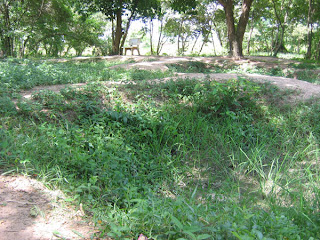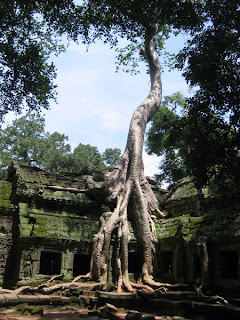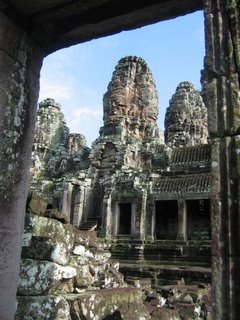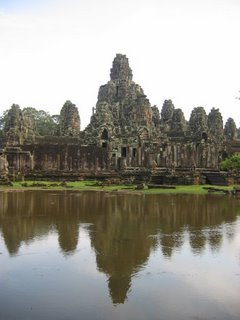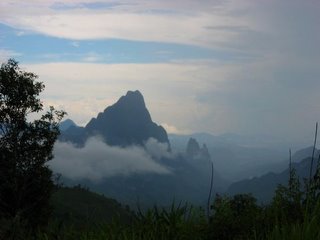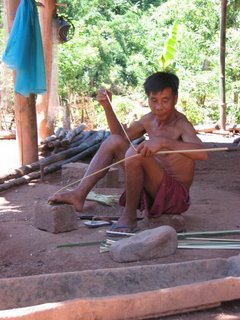A relatively short drive from Siem Reap, our next stop was Phnom Penn. Cambodia's capital city was, unsurprisingly, at the centre of the last thirty years of troubles and, like much of the country that surrounds it, has very much the feel of a work in progress. Amble along boulevard that follows the path of the Mekong as it meanders its now lazy way to the sea, taking in as you go the bustle of the river front cafes, or stroll around the serene palace gardens and you are left with the impression that Phnom Penn is just another relatively affluent South East Asian town. Stray a short distance from the tourist centre, however, and you quickly discover an alternate reality. Phnom Penn to a large extent is quite run-down and in many ways a little seedy. In places it carries the air of something not altogether wholesome, and you feel, occasionally, particularly late in the evening, that trouble may be lurking not too far away.
We were in Phnom Penn for just a couple of days. We spent our first evening in the hotel watching 'The Killing Fields', a British film that tells the story of an American journalist who, during the American evacuation from Phnom Penn, was forced to abandon his Cambodian friend to an uncertain future at the hands of the Khmer Rouge. The film, it has to be said, is not great cinematography (if I am any judge) but it did provide an excellent introduction to what happened here and placed firmly in context the main purpose of our visit: to see S21 and the killing fields.
Based in the grounds and buildings of an old school, S21 was the primary detention centre of the Khmer Rouge. Over the five years of Pol Pot's tenure this place played host to some 14000 prisoners. These were predominantly Cambodians thought to be political 'enemies' of the Communist party, along with a few unfortunate foreigners. At the height of the Marxist inspired party purges, to fall under suspicion as an 'enemy' was the simplest of things. It was enough to read the wrong book, to speak the wrong word or to be a family or friend of the wrong person. Such was the depth of Pol Pot's paranoia and the extremity of his regime. And as with so many 'witch hunts' throughout history once interred an inmate faced little opportunity for redemption. Confessions were extracted under the most extreme torture and the more evidence of traitors found the more extreme the purges became. This resulted inevitably in a self-perpetuating cycle of paranoia and violence. Of all the thousands of people confined here in the short time that S21 served as a prison only SEVEN survived the experience.
Left more or less as it was found by the Vietnamese, S21 has been turned into a 'museum of the genocide' and needless to say a visit here is a sobering experience. The stark bare classrooms still house the beds onto which prisoners were chained and photographs of them as they were discovered: tortured and executed adorn the walls. Other rooms contain board upon board of photographs, each one an erstwhile inmate. Every person who passed through S21 was photographed and documented. It is bizarre to consider that against a background of insanity so extreme such meticulous records could be kept. One can wander through the impossibly cramped, roughly constructed cells, see the torture devices used and read the testimonies of both prisoners and guards.
Some buildings resonate with the events of their past. This is such a place. Strolling around the now tranquil grounds one cannot help but feel that these walls are haunted by the thousands of souls who made the one-way passage through its gates. That S21 now stands in part as memorial and in part as a reminder of the events that were played out here is perhaps the best tribute there could be to the lives that were lost.
If the horrors of S21 need underlining then a visit to the killing fields is a chilling way to achieve it. As you enter the site you are immediately confronted with a quite beautiful pagoda style memorial, built to honour the people who ended here. Once again the quiet, tranquil nature of this place belies its violent history. Closer inspection reveals multitudes of bones, teeth and other assorted remains too small to be collected that lie scattered randomly across the earth. Entry into the memorial building reveals a tower full of thousands of skulls that have been exhumed from the slightly sunken mass graves that are laid out in relatively neat, regimented rows across the site. It is believed that the remains of some 80000 people reside at this site. Most of the victims of S21, presumably amongst other inmates from other similar establishments, were brought here to be executed and unceremoneously dumped. Everywhere is the evidence of destruction: this tree used for hanging; this spot where they killed infants; the evidence of harsh and brutal execution written permanently on the remains of the victims. It is common in Cambodia to come across people who were directly touched by this madness - it was only in 1996 that the fighting finally came to an end and on more than one occasion our guides gave personal accounts of their experiences of the fighting but nowhere was there more vehemently displayed emotion than on the face of the man who guided us around the killing fields.
Credit must be given to the Cambodians for the way in which these exhibits are presented. They have somehow managed to expose the realities without diminishing or glorifying their gravity. What remains is a frank and respectful expose on the events of the civil war. Nevertheless, the genocide tour is a macabre and in many ways unpleasant experience. It quite graphically lays bear the far extent of depravity that the human race can reach when embroiled in the extremes of unchecked fanaticism (be it political or religious). It is hard to imagine that anyone could walk away from this unaffected, but by the same token everyone is affected differently. Some found it hard even to look at the exhibits; some found it inappropriate to take photographs. For myself, as a guest in this wonderful, hospitable and friendly country, I felt compelled to see, and in my own small and totally inadequate way experience some of what happened here and to learn and try to remember the lessons that the Cambodians, through these exhibits, were trying to teach us. And so, shown here, are photographs and text that some may find distasteful. I make no apology. Nor do I intend a spectacle. This is the reality. These are the lessons. Take from it what you can.
